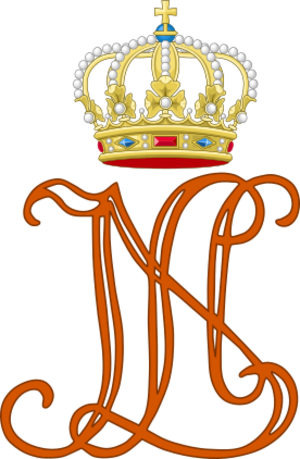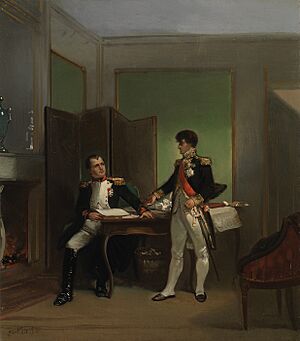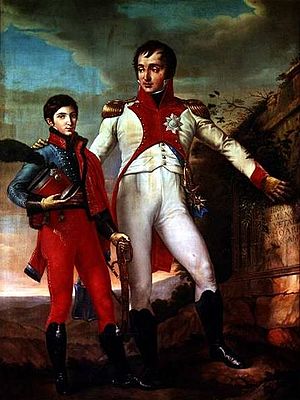Louis Bonaparte facts for kids
Quick facts for kids Louis Bonaparte |
|||||
|---|---|---|---|---|---|

Portrait by Charles Howard Hodges, 1809
|
|||||
| King of Holland | |||||
| Reign | 5 June 1806 – 1 July 1810 | ||||
| Successor | Louis II | ||||
| Born | 2 September 1778 Ajaccio, Corsica, Kingdom of France |
||||
| Died | 25 July 1846 (aged 67) Livorno, Grand Duchy of Tuscany |
||||
| Burial | Saint-Leu-la-Forêt, Paris | ||||
| Spouse | |||||
| Issue |
|
||||
|
|||||
| House | Bonaparte | ||||
| Father | Carlo Buonaparte | ||||
| Mother | Letizia Ramolino | ||||
| Religion | Roman Catholicism | ||||
| Signature |  |
||||
Louis Napoléon Bonaparte (born Luigi Buonaparte; 2 September 1778 – 25 July 1846) was a younger brother of Napoleon I, the Emperor of the French. From 1806 to 1810, he ruled the Kingdom of Holland. This kingdom was a French "client state," meaning it was controlled by France. It was located in the area of the modern-day Kingdom of the Netherlands. As king, he was known as Louis I (in Dutch: Lodewijk I).
Louis was the fifth of eight children who survived infancy. He was born on Corsica, an island that France had recently taken over. Louis joined the French Army, where his older brother Napoleon helped him advance. In 1802, he married Hortense de Beauharnais. She was the daughter of Empress Joséphine, Napoleon's wife.
In 1806, Napoleon created the Kingdom of Holland. He made Louis its new king. Napoleon wanted Holland to be a puppet state, controlled by France. But Louis wanted to rule as independently as possible. He became quite popular with the Dutch people. Napoleon grew tired of Louis's independent ways. In 1810, he took over Holland and made it part of the French Empire. Louis then went into exile.
Louis's youngest son, Louis-Napoléon, later became Emperor Napoleon III of France in 1852.
Contents
Louis Bonaparte: Early Life and Career
Louis was born in Ajaccio, Corsica. He was a younger brother to Joseph, Napoleon, Lucien, and Elisa. He was also an older brother to Pauline, Caroline, and Jérôme. Louis's godparents were important people on the island.
Louis started his career in the Army. He served with Napoleon in Egypt. Thanks to Napoleon, Louis quickly rose through the ranks. He became a Lieutenant and then an Aide de Camp on Napoleon's staff. During Napoleon's Italian Campaign, Louis was promoted to captain. By age 25, he became a General. He felt he had been promoted too quickly.
When Louis returned to France, he helped Napoleon overthrow the French government. After Napoleon became the First Consul, he arranged for Louis to marry Hortense de Beauharnais. She was Napoleon's stepdaughter. Hortense did not want to marry Louis at first. But her mother persuaded her to do it for the family.
Louis sometimes felt sad or unwell. These periods of feeling down affected him throughout his life.
King of Holland (1806–1810)

Napoleon felt that the Batavian Republic was too independent. So, on June 5, 1806, he replaced it with the Kingdom of Holland. He then placed Louis on the throne. Napoleon wanted Louis to be like a French governor in Holland. However, Louis wanted to be a responsible and independent ruler.
Becoming a Dutch King
To connect with his new country, Louis tried to learn the Dutch language. He called himself Lodewijk I, which is the Dutch form of his name. He also declared himself Dutch, not French. People say his Dutch was so bad at first that he called himself "Rabbit of 'Olland" instead of "King of Holland." But his honest effort to learn Dutch earned him respect.
Louis wanted his court to be Dutch too. He made his court and ministers speak only Dutch. He also asked them to give up their French citizenship. His wife, Hortense de Beauharnais, was in France at the time. She refused his request. Louis and Hortense did not get along well, and this made their relationship even worse. Hortense came to Holland unwillingly and tried to avoid Louis.
Louis often changed the location of his capital city. He moved it over a dozen times, trying Amsterdam, The Hague, and Utrecht. Once, he liked a wealthy merchant's home so much that he made the owner move out. Louis then lived there for only seven weeks before moving again. His constant moving made it hard for his court and foreign diplomats to keep up. This restlessness was later seen as a sign of his unsettled nature.
Hortense gave birth to Louis's sons, Napoléon Charles Bonaparte and Napoléon Louis Bonaparte, in Paris. In 1806, Louis asked for his son to be sent to him in Holland. But Hortense refused, fearing her son would not return to France. When Louis asked Napoleon for help, Napoleon sided with Hortense. Napoleon kept the boy in his own court. He even named him the heir to the French throne before his own son was born.
Challenges and Abdication
Two big problems happened during Louis's rule. In 1807, a ship carrying gunpowder exploded in Leiden. In 1809, there was a major flood in Holland. In both cases, Louis personally helped with the relief efforts. This earned him the nickname "Louis the Good." Napoleon was not pleased. He said, "Brother, when they say of some king or other that he is good, it means that he has failed in his rule."
Louis Bonaparte's reign was short. Napoleon wanted to reduce the value of French loans from Dutch investors. This would hurt the Dutch economy. Also, Napoleon was preparing to invade Russia. He wanted troops from all countries under his control, including Holland. Louis refused to send Dutch troops.
Napoleon accused Louis of caring more about Dutch interests than French ones. He removed most French soldiers from Holland. This left only about 9,000 soldiers to defend the country. In 1809, the English landed an army of 40,000 soldiers. Louis could not defend Holland alone. France sent 80,000 soldiers to help. They successfully stopped the invasion.
Napoleon then suggested that Louis should give up his throne. He said Louis could not protect Holland. Louis refused and said the French army's occupation was illegal. On July 1, 1810, Louis gave up his throne in favor of his second son, Napoleon Louis Bonaparte. He fled to Austria. Napoleon then officially made Holland part of France on July 9.
Life After Being King

After giving up his throne, Louis Bonaparte used the title Count of Saint-Leu. This referred to his property near Paris. He was also given an honorary title as Constable of France in 1808.
The Austrian Emperor Francis I offered Louis a safe place to stay. From 1811 to 1813, Louis lived in Graz, where he spent his time writing and creating poetry. After Napoleon's defeat in Russia, Louis asked him to restore the Dutch throne. But Napoleon refused.
Louis wanted to visit the Netherlands several times. King William I of the Netherlands said no. But King William II allowed him to visit in 1840. Louis traveled under a false name. But some people found out it was their former king. A cheering crowd gathered outside his hotel room. It is said that he was very touched by this show of affection from his former subjects.
After his oldest brother Joseph died in 1844, Louis was seen by some as the rightful Emperor of the French. However, Louis did not try to claim the throne himself. Louis's son and heir, the future Emperor Napoleon III, was in prison in France at that time for trying to take power.
Louis Bonaparte died on July 25, 1846, in Livorno. He was buried in Saint-Leu-la-Forêt, France.
Family Life
Louis married Hortense de Beauharnais on January 4, 1802. She was the daughter of Josephine, Napoleon's first wife. So Hortense was also Louis's step-niece. This marriage was arranged and was not a happy one. The Bonaparte family, except for Napoleon, generally disliked the Beauharnais family.
Hortense de Beauharnais gave birth to three sons:
- Napoleon Charles Bonaparte: Born October 10, 1802. He was the Prince Royal of Holland. He died on May 5, 1807, at 4 years old. He is buried in Saint-Leu-La-Forêt, France.
- Napoleon Louis Bonaparte: Born October 11, 1804. He became Prince Royal of Holland after his brother's death. He was King for eight days in 1810, between his father's abdication and Holland becoming part of France. He died from measles on March 17, 1831. He is buried in Saint-Leu-La-Forêt, France.
- Charles Louis-Napoleon Bonaparte: Born in Paris in 1808. He was the third and last son. He later became Emperor Napoleon III of the Second French Empire (1852–1870).
See also
 In Spanish: Luis Bonaparte para niños
In Spanish: Luis Bonaparte para niños





